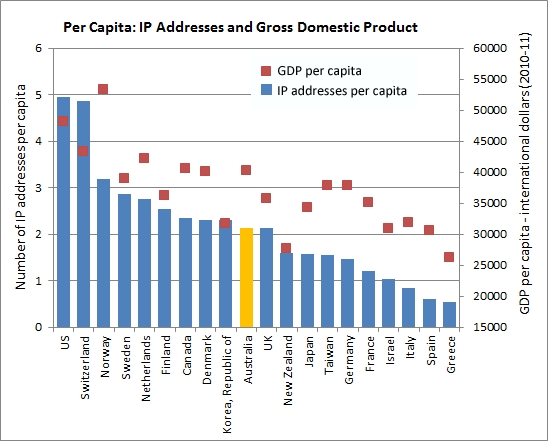By the numbers: addressing a digital divide

We're seeing a growing productivity divide between countries that fully embrace the internet and those who are have yet to. So where does Australia sit?
There's little doubt that increased connectivity brings productivity benefits. First, the internet made it easier to get things done; the addition of smartphones meant that we could do more on the go. Next, we'll see more and more machine-to-machine (M2M) activity, giving productivity an even greater nudge forward.
So the level of connectivity is a strong indication of how much countries embrace the drive for productivity. One way to measure this is by the number of IP addresses active in each country. By calculating the IP density — the number of IP addresses per capita — we get an indication of the relative adoption of devices, and the creation of web-based content and applications.
Such an analysis highlight two standout leaders: the US and Switzerland, each with almost five addresses per person. In the next tier are nine countries with more than two addresses per capita, one of which is Australia(and three are in Scandinavia).
With one exception, countries in this second tier are less wealthy (measured as Gross Domestic Product per capita) than the two market leaders. The exception is Norway, whose high labour productivity has created an economy that's difficulty to beat (and is known for widespread IT adoption).

(Credit: Phil Dobbie/ZDNet Australia; Data source: Whois)
So, why are countries with higher IP densities wealthier? One obvious answer is that they can afford to buy more devices. But the relationship could also be causal. Let's remember that many of these addresses will be used for business purposes, rather than fun, so it's likely that those with low take-up will struggle to match the leaders when it comes to productivity gains. European countries that are suffering the most right now, for example, all have IP address densities that fall well outside the top two tiers.
This is all positive news for Australia. We rank highly on the world scale of connectivity and national wealth. We suffer, of course, because the GDP per capita is spread unevenly, spurred by our resources boom. But improving our connectivity — facilitated by projects like the National Broadband Network — should help boost productivity and have the benefits felt across society, as a whole.
So assume we made it a goal for Australia to match the US by doubling our level of connectivity — would our wealth rise to meet that of America; if so, it would mean a 20 per cent lift in our gross domestic product (GDP) per capita.
Of course, the relationship between the two factors isn't so direct, but what is certain is that we are seeing the emergence of a wealth gap, even in the developed world, between those countries who are highly connected and those who are not. Thankfully, at the moment, we are sitting on the right side of the divide.